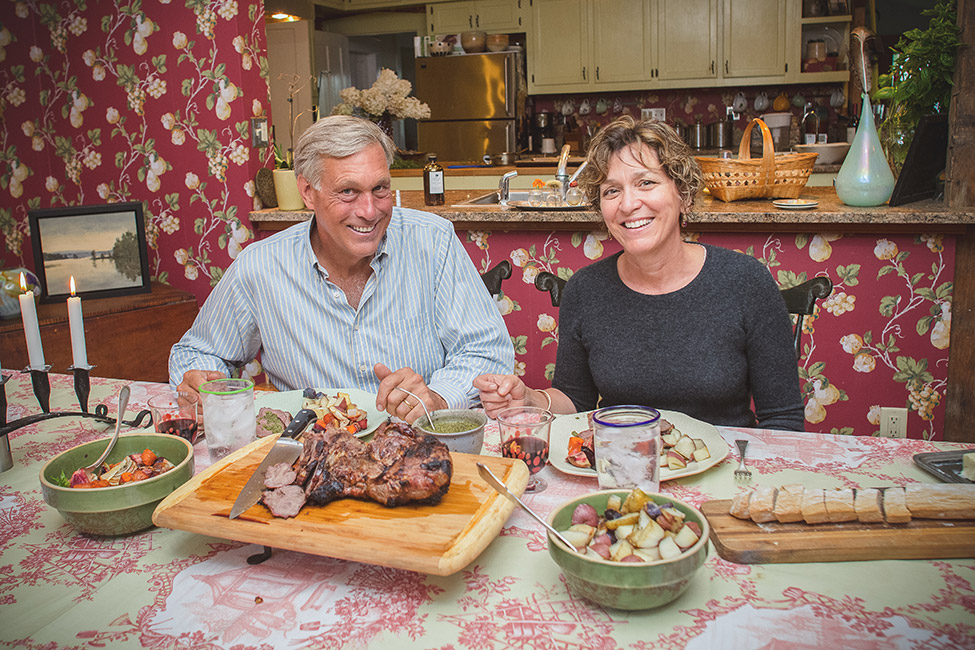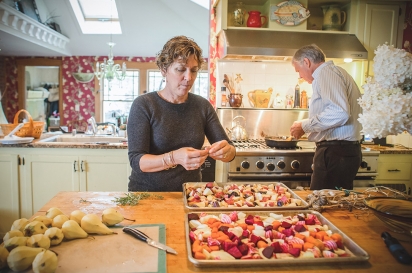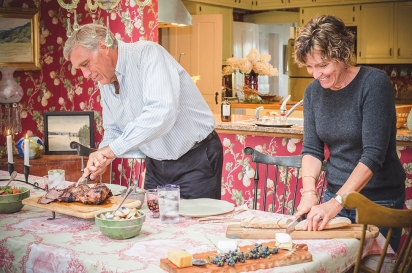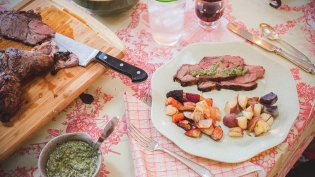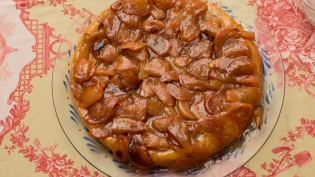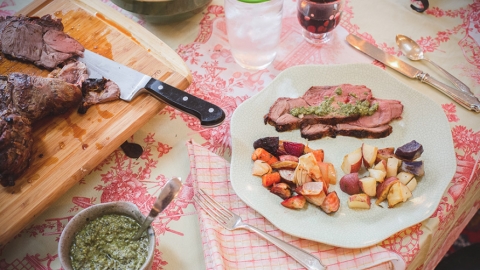Robert and Katherine DuGrenier
It’s a long and winding road up the side of a small mountain in West Townshend, but once you arrive at Taft Hill Farm, you understand in a breathtaking moment just what a Vermont hill farm is all about and the reason Robert and Kathy DuGrenier fell in love with the perfection of this historic place in 1997.
Aaron Taft, great-grandfather of President William Howard Taft, established the 100-acre farm in 1775, when Townshend was still wilderness frontier. His grandson and the president’s father, Alphonso, left Vermont for Ohio after completing his education and law studies at Yale in 1839. The original house was replaced in 1790 and in 1848 achieved its current footprint. Though the last ties to family ended in the early 1900s, the land continued to be called Taft Hill and the farmhouse was just waiting for some imaginative attention.
Robert, a world-renowned glassblower and gifted designer, had spent much of his childhood on his grandparents’ dairy farm. “It was my dream to return to that life,” he says. “I knew I could not feel fulfilled until I was producing my own food for my family.” He had a kaleidoscope of ideas for what the farm could be, and their homestead quickly became a beehive of activities. There were weddings on the lawn under tents and New Year’s Eve parties that filled the house with friends who brought their children for midnight skating parties on the pond and fireworks with s’mores by the bonfire and Champagne for the parents. It was a house of many rooms that invited the gathering of family and friends. Over the years they expanded the original footprint, putting in a new kitchen and dining area and building a great room on the back with tall windows to take in the sunset over the Green Mountains.
The sugarhouse went up and the tubes were laced among the over 300 sugar maples on the south-facing hillside. Late winter the boiling began and the much-anticipated first bottles of Taft Hill maple syrup with their distinctive labels filled their shelves. “We are now producing over 60 gallons of maple syrup every year, which we also sell at the local farmers market,” explains Robert. They have also recently started brewing up some very tasty maple-wheat beer.
A large barn, salvaged from up the road, came next to accommodate the arrival of animals both practical and exotic. First came the chickens (Sugarbush and Copper Scotch) then the llamas and the sheep (crossbred mouflon and Jacob’s four-horned). They were joined by several pigs, miniature donkeys and a rare Randall cow, a purebred strain used for over 400 years on New England dairy farms and a breed that almost went extinct. Two Bhutanese peacocks roam the farm protecting the poultry from predators and even an emu found a comfortable home. A beehive sits in the upper garden, where resident bees bring their own distinctive taste of place to the mix.
Over the last 15 years, Robert and Kathy, along with their son, Luc, have been working toward building a farm that brings them the enjoyment and satisfaction of living off exclusively what they raise. Their vegetable garden has grown larger every year, filled with heirloom varieties of vegetables and herbs. They added blueberries and blackberries and Concord grapes and planted apple, pear, cherry and peach as well as black walnut trees. Every year they plan how to increase the variety of foods they can harvest. They are now working on producing their own wheat crop using seedlings of Champlain Valley wheat, a rare hybrid originally developed in the 1870s.
“A crucial element to maintaining the farm is the help we receive from our WWOOFers,” explains Kathy. World Wide Opportunities on Organic Farms (WWOOF) is an international exchange organization that links volunteers from all over the world with host farms that provide food, accommodations and the chance to learn about organic farming lifestyles in exchange for their labor. The volunteers come for anywhere from several weeks to several months and live in a large two-bedroom apartment over the giant garage Robert built to store all the farm equipment that steadily accumulated.
In recent years there has been a growth in the number of young farmers in the area, creating a thriving community of like-minded homesteaders who appreciate the hard work involved and are taken with the authentic living. The West Townshend Country Store, revived in 2011 under Robert’s leadership, has become the meeting place for neighbors interested in sustainability and development of local food production.
Celebrating a holiday with the DuGreniers is an invitation not to be refused. They are famous in their extensive network of friends for their inspired parties, always centered around some delectable dishes they are cooking up from the farm’s bounty. The centerpiece this year is a young lamb from their herd, butterflied and marinated in yogurt, lemon and rosemary. While Robert makes the baguettes, Kathy prepares a variety of potatoes for roasting, including some gorgeous Blue Peruvians. Also being prepared for roasting is a tray of tender carrots, fennel and red beets, all from their garden.
Once the bread is rising in the proofing oven, Robert turns his attention to dessert, his special take on the traditional tarte tatin. First he makes a hot-water crust by combining flour, boiling water and butter. The dough will rest in the refrigerator for one hour. In a large black cast-iron frying pan he pours a cup of Taft Hill maple syrup, reducing it over high heat until it is caramelized. To this he adds a stick of butter and some heavy cream, continuing to stir until it is creamy. “I’m using Seckel pears for this tarte, but you can also use firm, tart apples.” The dozen pears are peeled and sliced into thin wedges and then scattered on a sheet pan to bake for a few minutes “to release the moisture and keep the tarte from being soggy.” The pear slices are then carefully placed in an overlapping round pattern over the maple cream. The dough is rolled and pressed firmly over the top and the tarte joins the vegetables in the oven. When nicely brown on top and bubbling, the tarte is turned out upside down onto a plate.
Their choreography looks effortless as they move around the large kitchen all the while talking to their guests who are seated on 1950s soda fountain stools at the high counter. “We love to cook and even have our guests help if they wish,” says Kathy. “But they are also welcome to just pour the wine.”
When all is ready, the lamb is prepared for the grill. After wiping off the marinade, Robert inserts dozens of slivers of garlic into the lamb and places the meat onto the hot grill just outside the kitchen door. “Unlike the woolly sheep we are so accustomed to seeing, our sheep are the hair variety and have no lanolin in their makeup so they don’t have that taste some people don’t like,” he explains. While the lamb is cooking, he prepares a pesto made of garlic scapes, black walnuts, fresh mint and a little cream. The taste is delightfully tart and complex.
Having friends and family gather round their table to enjoy the good food from Taft Hill Farm is their greatest pleasure. “We believe that it’s crucial to fully realize the potential of this rural environment,” says Robert. And what a delicious realization this continues to be.
Frederica Templeton is grateful for all the cooks in her family who make the holidays a rare treat.


